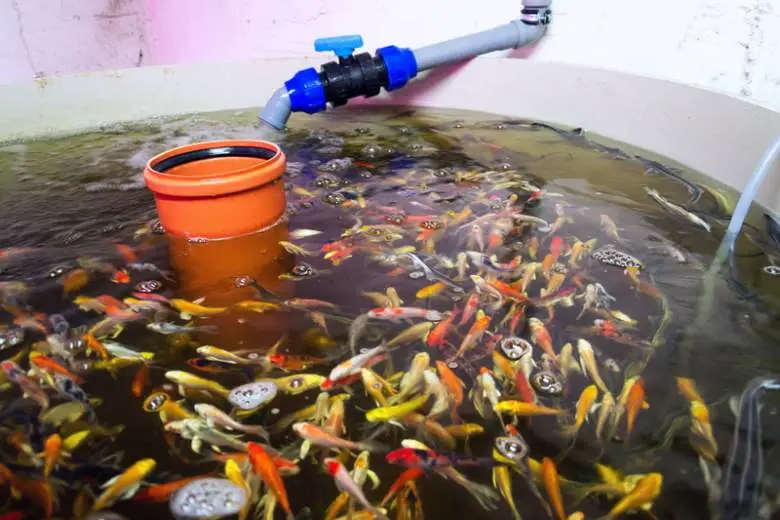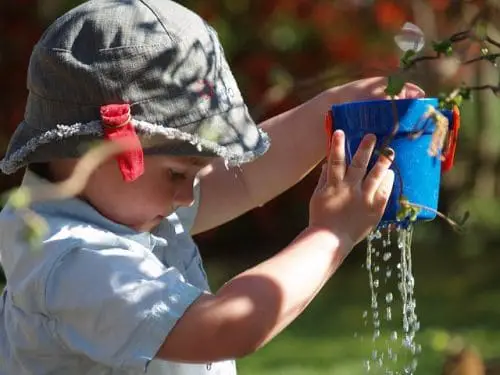Aquaponics is very similar to Hydroponics in function and system design to a certain degree. Both are soilless systems and use water as the primary way of delivering nutrients. Hydroponics requires frequent water changes, so new gardeners can often ask the following question.
Do you need to change the water in Aquaponics? Besides using fish as the source of nutrients in an Aquaponics system, the second most significant difference is you never need to change the water. You will need to top up water lost to evaporation, etc.; however, the system is self-cleaning when in operation.
Why Aquaponics Works?
Aquaponics mimics natural waterways and is a highly efficient way to grow food crops in small areas, yet systems are sustainable.
The primary input in Aquaponic systems is fish food, and as this is eaten, there is a fish waste. Over 50% of the fish waste produced by fish comes as ammonia they secrete in urine and smaller quantities through their gills.
The remainder of this waste is excreted, where it goes through a process called mineralization. Here, heterotrophic bacteria consume fish waste, decaying plant matter, and uneaten food, and all these create ammonia and other compounds.
Once the levels of ammonia rise above certain levels, they become toxic to fish and plants.
In soil, air, and water, you find Nitrifying bacteria, which can convert ammonia first into nitrites, and from there, they create nitrates that plants consume.
Heterotrophic and nitrifying bacteria cling to tank walls, under rafts, growing media, and organic matter in your system.
Such beneficial bacteria are natural and inhabit an aquaponic system when there is any sign of ammonia and nitrite present.
You have three things to keep alive and healthy in an Aquaponic system. You have your fish, plants, and the resulting beneficial bacteria.
All these rely on each other to live and create a circulating system where every party’s needs are fulfilled. Bacteria consume fish waste to keep the water clean for the fish. Meanwhile, the bacteria provide plants with a supply of usable nutrients.
As the plants grow, they use these nutrients, and by doing so, they act as a filter to clean the water the fish live in.
Is There Any Reason to Change Water in Aquaponics?
One of the key reasons you may need to intervene and change the water in an Aquaponic system is if you have a severe algae problem.
Algae is a major nuisance and can cause many problems. Two areas that it can affect are the nutrients for your plants and your system’s pH.
An aquaponic system is a self-contained eco-system, and it is for this reason you shouldn’t have ever to change your water.
Not only this, but when you first build a system, they need to cycle to produce the right environment for your plants and fish.
Before you consider changing water, here are some things you can do to help prevent the accumulation of algae.
Read more: How to Get Rid of Algae in Hydroponics?
Shading
Shading is the quickest and easiest way to reduce algae in your system. Green algae need light to grow and reproduce. You can use either shade your tanks or cover them with a dark-colored tarp or plastic.
Many growers do paint sump tanks and any transparent plastic black and then white on top as this can reflect the sun and stop water heating up.
On media beds, if you have algae issues on the surface of your media bed or Bato buckets, you can shade by adding more rock or gravel to stop light from reaching the moist areas.
Filtration
Mechanical filtration can play a significant role in algae removal. Equipment can be expensive, although it’s easy to build. You can use filters, screens, vortex, or centrifugal settlement equipment to remove algae from your system.
A grow bed in your system will act as a large mechanical filter and strain algae from your water.
Alternatives
One alternative some gardeners resort to is using Humic Acid. In a deep tank, you can see the water darken from the addition of this. It is this that helps stop algae growth. You can add humic acid as it is beneficial for your plants to help chelate plant nutrients.
Why You Don’t Need to Change Aquaponic Water
Besides ensuring all your pipes and pumps are clean and working correctly. You will find little you need to do in dealing with your water besides checking pH levels.
You will discover much of this because an aquaponic system creates an eco-system rather than a system, which is fed nutrients as in Hydroponics.
Here you can see the functions of the three zones you will have in your system. It is the function of these to deliver nutrients by breaking down waste—the distribution of this nutrient-rich waste and the sealing layer that aids in preventing evaporation and algae growth.
One thing to note is the depth of your grow bed. It is recommended to have 12 inches, although many growers say you can use a regular hydroponic flood table. While possible, it makes the zones far thinner and restricts the range of vegetables you can grow.
Besides the volume of growing media (gravel) and your grow beds’ weight, it is advisable to aim for twelve inches for the best conditions.
Here is a breakdown of the zones and their function.
Zone 1 – The Surface Zone
The uppermost 2-inches of the surface serves two functions. First, we saw it stops a considerable amount of moisture evaporation because of the dry zone it creates.
Second, pea gravel that is dry in this area helps stop collar rot on your crops. You’ll also find the chances of powdery mildew are reduced, and as we have seen, it can stop algae growth.
Zone 2 – Root Zone
Of all the three zones, it is here where the most activity happens, and all the magic happens. You’ll find this root zone ends up around 6-8 inches in depth. Once the bed has been flooded and drains, you get optimal oxygen delivery to your crops’ roots.
All the activity comes from microbes, worms, and beneficial bacteria that accumulate.
It is the flood cycle that distributes all the waste particles across the growing bed. Works break down any solid matter and release minerals into the worm tea. When you flood again, this worm tea mixes with your water to spread around the roots of your crops.
Zone 3 – Mineralization
In the lowest 2 – 3 inches, you find a slurry of fish waste solids and worm castings. From the first entrance to the system, they will be reduced by around 60% in volume.
Once you carry out your flood and drain cycles, the zone receives a boost of freshness by the actions of the most recent delivery of oxygen-rich water.
Also read: Can You Grow Root Vegetables With Aquaponics?
Conclusion
You have no reason to change the water in an aquaponics system, yet this doesn’t mean you won’t have maintenance. Even with filters and everything else in place, you can end up with blocked pipes or water pumps.
Your system will do as much as it can to care for itself, yet to make sure you get the best results, it doesn’t hurt to add a helping hand.





